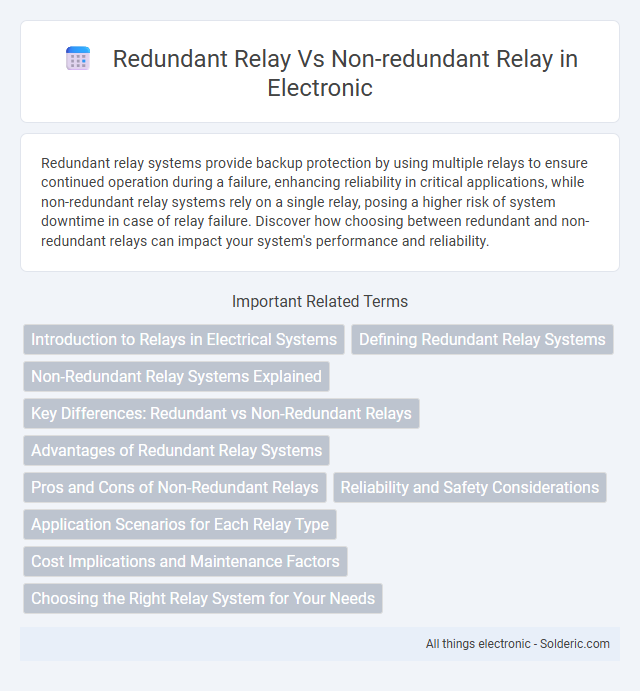Redundant relay systems provide backup protection by using multiple relays to ensure continued operation during a failure, enhancing reliability in critical applications, while non-redundant relay systems rely on a single relay, posing a higher risk of system downtime in case of relay failure. Discover how choosing between redundant and non-redundant relays can impact your system's performance and reliability.
Comparison Table
| Feature | Redundant Relay | Non-Redundant Relay |
|---|---|---|
| System Reliability | High - backup relay ensures continuous operation | Low - single point of failure |
| Cost | Higher - extra equipment and installation | Lower - fewer components |
| Maintenance | Complex - requires monitoring of both relays | Simple - only one relay to maintain |
| Application | Critical systems needing maximum uptime | Non-critical or budget-sensitive systems |
| Fault Tolerance | High - backup relay takes over on failure | None - failure results in system outage |
| Installation Complexity | Moderate to high | Low |
Introduction to Relays in Electrical Systems
Relays in electrical systems serve as crucial switches that control circuit operations by using electromagnetic or solid-state mechanisms. Redundant relays enhance system reliability by providing backup switching capabilities, ensuring continuous operation during component failures. Non-redundant relays, while simpler and more cost-effective, lack this fail-safe feature and may lead to system downtime if a relay fails.
Defining Redundant Relay Systems
Redundant relay systems consist of multiple relays working in parallel to ensure continuous protection and fault detection in electrical circuits, minimizing the risk of failure due to a single relay malfunction. Non-redundant relay systems rely on a single relay for protection, which may increase vulnerability to system downtime if that relay fails. Understanding the structure of redundant relay systems helps you enhance reliability and maintain consistent operation in critical electrical applications.
Non-Redundant Relay Systems Explained
Non-redundant relay systems rely on a single relay to perform switching or protection functions, making them simpler and cost-effective but more vulnerable to failure. In contrast, redundant relay systems use multiple relays to ensure continued operation if one fails, enhancing reliability and system uptime. Choosing a non-redundant relay may suit smaller or less critical applications, but your system's safety and continuity depend heavily on evaluating the risk of potential relay failure.
Key Differences: Redundant vs Non-Redundant Relays
Redundant relays provide increased reliability by using multiple relay components to ensure circuit protection even if one relay fails, while non-redundant relays rely on a single relay device for operation. Redundant relays are essential in critical systems where uninterrupted performance is crucial, reducing the risk of downtime and system failure. Your choice between redundant and non-redundant relays should consider the importance of reliability, cost constraints, and specific application requirements.
Advantages of Redundant Relay Systems
Redundant relay systems offer enhanced reliability by providing backup protection in case of a relay failure, minimizing the risk of power outages and equipment damage. These systems improve system stability and operational continuity, particularly in critical infrastructure such as power plants and substations. By enabling fault tolerance and reducing downtime, redundant relays contribute significantly to maintaining uninterrupted electrical grid performance.
Pros and Cons of Non-Redundant Relays
Non-redundant relays offer simplicity and cost-effectiveness, making them suitable for applications where system downtime is less critical. Their main drawback is the lack of backup, which increases the risk of total system failure if the relay malfunctions. You should weigh these factors carefully when deciding whether the reduced reliability justifies the initial savings in your electrical system design.
Reliability and Safety Considerations
Redundant relays significantly enhance reliability by providing backup protection that ensures continuous operation even if one relay fails, minimizing the risk of system downtime or faults. Non-redundant relays lack this backup, increasing vulnerability to single points of failure and potentially compromising safety in critical applications. Implementing redundant relay systems is essential in high-stakes environments, such as power grids and industrial automation, where maximum operational safety and fault tolerance are required.
Application Scenarios for Each Relay Type
Redundant relays are essential in critical applications such as power plants, data centers, and industrial automation systems where continuous operation and fail-safe protection are paramount. Non-redundant relays suit less critical scenarios like basic motor control and simple lighting circuits where cost-effectiveness and simplicity take precedence. Your choice between these relay types depends on the required reliability and potential impact of system failures.
Cost Implications and Maintenance Factors
Redundant relays increase initial costs due to additional equipment and installation but improve system reliability, potentially reducing long-term expenses from downtime and emergency repairs. Non-redundant relays have lower upfront costs but may lead to higher maintenance and failure risks, resulting in costly outages. Your choice affects both budget and maintenance strategies, balancing cost implications with operational continuity.
Choosing the Right Relay System for Your Needs
Choosing the right relay system depends on the criticality of your application and required reliability levels. Redundant relays offer higher fault tolerance and continuous operation in case one relay fails, making them ideal for mission-critical systems such as power grids and industrial controls. Non-redundant relays provide cost-effective solutions for less critical tasks where occasional downtime is acceptable, optimizing budget without sacrificing essential functionality.
redundant relay vs non-redundant relay Infographic

 solderic.com
solderic.com